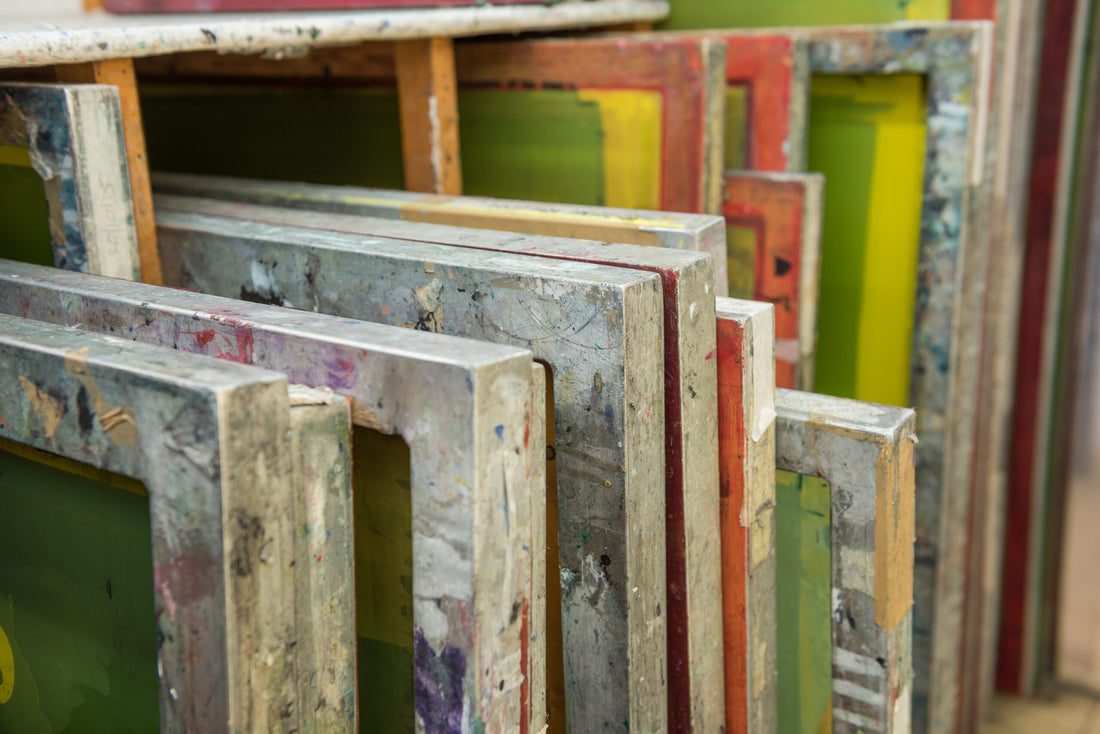
How to Clean Screen Printing Screens Step by Step
Share
Screen printing is a popular printing method used to create high-quality prints on a variety of surfaces. However, dirty screens can result in poorly printed images or even damage to the screen. Therefore, it is essential to learn how to clean screen printing screens properly. In this article, we will discuss the step-by-step process of cleaning screen printing screens, including how to remove tape, ink, and emulsion.
 Once the ink has been removed, you can apply a cleaning solution like Victory Factory Ink Wash to the screen. There are many different cleaning solutions available, but it is important to choose one that is specifically designed for screen printing screens. Apply the cleaning solution to both sides of the screen.
Once the ink has been removed, you can apply a cleaning solution like Victory Factory Ink Wash to the screen. There are many different cleaning solutions available, but it is important to choose one that is specifically designed for screen printing screens. Apply the cleaning solution to both sides of the screen.
 Once the screen has been scrubbed, rinse it with water. Be sure to rinse both sides of the screen thoroughly to remove any remaining ink and cleaning solution.
Once the screen has been scrubbed, rinse it with water. Be sure to rinse both sides of the screen thoroughly to remove any remaining ink and cleaning solution.
 If you need to remove the emulsion from the screen, you can use an emulsion remover. Apply the emulsion remover to both sides of the screen and use a scrub brush to scrub the emulsion away.
If you need to remove the emulsion from the screen, you can use an emulsion remover. Apply the emulsion remover to both sides of the screen and use a scrub brush to scrub the emulsion away.
Introduction
In this section, we will briefly introduce screen printing and the importance of cleaning screens.What is Screen Printing?
Screen printing is a printing technique that involves using a mesh screen to transfer ink onto a surface. The screen is stretched tightly over a frame, and a stencil is applied to block out areas where ink should not be applied.Why Clean Screen Printing Screens?
When properly cleaned screen printing screens can be reused for new projects.Step-by-Step Guide to Cleaning Screen Printing Screens
In this section, we will provide a detailed guide on how to clean screen printing screens, including steps to remove tape, ink, and emulsion.Step 1: Remove the Tape
The first step in cleaning a screen printing screen is to remove any tape that may be on the screen. Use a scraper or a squeegee to remove the tape from the screen.Step 2: Remove the Ink
The next step is to remove any excess ink from the screen. You can use a scraper or a squeegee to remove the ink from the screen. Be sure to scrape the ink off both sides of the screen. You can use a plastic scraper and a rag.Step 3: Apply a Cleaning Solution
 Once the ink has been removed, you can apply a cleaning solution like Victory Factory Ink Wash to the screen. There are many different cleaning solutions available, but it is important to choose one that is specifically designed for screen printing screens. Apply the cleaning solution to both sides of the screen.
Once the ink has been removed, you can apply a cleaning solution like Victory Factory Ink Wash to the screen. There are many different cleaning solutions available, but it is important to choose one that is specifically designed for screen printing screens. Apply the cleaning solution to both sides of the screen.
Step 4: Scrub the Screen
After applying the cleaning solution, use a scrubbing pad or a brush to scrub the screen gently. Be sure to scrub both sides of the screen thoroughly.Step 5: Rinse the Screen
 Once the screen has been scrubbed, rinse it with water. Be sure to rinse both sides of the screen thoroughly to remove any remaining ink and cleaning solution.
Once the screen has been scrubbed, rinse it with water. Be sure to rinse both sides of the screen thoroughly to remove any remaining ink and cleaning solution.
Step 6: Remove the Emulsion
 If you need to remove the emulsion from the screen, you can use an emulsion remover. Apply the emulsion remover to both sides of the screen and use a scrub brush to scrub the emulsion away.
If you need to remove the emulsion from the screen, you can use an emulsion remover. Apply the emulsion remover to both sides of the screen and use a scrub brush to scrub the emulsion away.
Step 7: Rinse the Screen Again
Once the emulsion has been removed, rinse the screen with water again. Be sure to rinse both sides of the screen thoroughly to remove any remaining emulsion remover.Step 8: Dry the Screen
Finally, dry the screen using a clean, lint-free cloth or a blow dryer. Be sure to dry both sides of the screen thoroughly.Tips for Cleaning Screen Printing Screens
In this section, we will provide some additional tips for cleaning screen printing screens.Tip 1: Clean Screens Regularly
Regular cleaning of screen printing screens is essential for maintaining their quality and longevity. It is recommended to clean screens after every use.Tip 2: Use the Right Cleaning Solution
Using the wrong cleaning solution can damage the screen. It is important to use a cleaning solution that is specifically designed for screen printing screens.Tip 3: Be Gentle
When cleaning screen printing screens, it is important to be gentle to avoid damaging the screen. Use a soft-bristled brush and avoid using harsh chemicals or abrasive materials.Tip 4: Store Screens Properly
Properly storing screens can also help prolong their lifespan. Store screens in a dry, cool place away from direct sunlight and moisture.Tip 5: Replace Damaged Screens
If a screen becomes damaged, it is important to replace it as soon as possible. Using a damaged screen can result in poor quality prints and even damage to the printing equipment.Conclusion
In conclusion, cleaning screen printing screens is an essential part of maintaining their quality and longevity. By following the step-by-step guide outlined in this article and implementing the tips provided, you can ensure that your screens remain in top condition for years to come.FAQs
- How often should I clean my screen printing screens?
- It is recommended to clean screens after every use to maintain their quality.
- Can I use any cleaning solution to clean my screens?
- No, it is important to use a cleaning solution that is specifically designed for screen printing screens to avoid damage.
- Should I replace a screen if it becomes damaged?
- Yes, using a damaged screen can result in poor quality prints and even damage to the printing equipment.
- Can I reuse emulsion after removing it from a screen?
- No, emulsion cannot be reused once it has been removed from a screen.
- Can I store screens in a humid environment?
- No, it is important to store screens in a dry, cool place away from direct sunlight and moisture to prevent damage.
